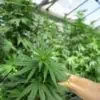TABLE OF CONTENTS
After a period of vegetative growth, a change in the light cycle can trigger cannabis plants to begin their flowering phase. During this exciting time, pre-flowers develop into full-grown buds covered with resinous trichomes. Here is everything you need to know about the flowering phase of cannabis.
What Is the Flowering Phase of Cannabis?
In the wild, cannabis plants get up to 18 hours of light per day in the summer. In the northern hemisphere, June 21 (summer solstice) is the year's longest day. On September 22 (fall equinox), the day and night are 12 hours long. From there, the days keep getting shorter.
When cannabis plants detect increased time spent in the dark over light, they begin to flower. Growers may remove fan leaves that look unhealthy or block airflow, reducing the risk of bud rot and allowing the plant to focus its energy on growing big flower buds.
Growing Requirements for the Flowering Phase of Cannabis
You do not have much control over the light, wind, and water when growing outdoors unless you have a greenhouse. In indoor gardens, you can control every aspect of the environment to your plant's specific needs.
Optimal indoor garden conditions for the weed flowering stage:
- Temperature – 75º F (24º C) +/-2º
- Light – 12 hours of light; 2700K; MH or LED bulb
- RH% – 45% (+/-5%)
- Nutrients – Low nitrogen; High phosphorus; Medium potassium
How Long Is the Flowering Phase of Cannabis?

Flowering stage timelines vary depending on seed genetics and the growing environment. The flowering stage of a cannabis plant can last between six and 22 weeks. Indica strains can finish after eight weeks of flowering, while sativa strains may finish in 12 to 14 weeks.
An Exception to the Rule: Autoflowering Cannabis Plants
While most female cannabis plants begin flowering when there is a change in the light cycle, some varieties of the cannabis plant (autoflowering strains) have evolved to start flowering without the need for a change in the light cycle.
Cannabis that evolved in high latitude areas such as Siberia gets almost 24 hours of light per day during the peak of summer. In this extreme environment, cannabis ruderalis developed with autoflowering characteristics to ensure the seeds developed before winter came.
Flowering Phase of Cannabis: Week-by-Week
The flowering phase of cannabis varies depending on the strain genetics and your growing environment. We have provided a general week-by-week breakdown of the cannabis plant’s flowering stage.
Read our blog resource on how to transition from the vegetative stage to the flowering stage for a seamless process into the plant’s final stage.
Week 1-3
The flowering stage begins when indoor growers change to a 12-12 light cycle or when the days get shorter outdoors. Letting your plant receive the 12 hours of darkness without light leaks can trigger the flowering stage. Watch out for light leaks, which can revert your plant to its vegetative stage or induce hermaphroditism.
During the first few weeks of the marijuana flowering stage, you may see a growth spurt. Some cannabis plants can nearly double in size when during the flowering period. Be sure to research your genetics and ensure you have enough room for its expected height.
Keep a close eye on bud formation throughout this early stage. If you start with the regular seeds, you will have to ensure there are no male plants in the bunch. Males grow pollen sacs and should be removed from the grow space as soon as possible to prevent accidental pollination of female plants. This can reduce your yield and cause hermaphroditic characteristics.
Flowering plants develop white pistils that collect the pollen from males. Pistils develop at the bud sites where leaves meet the primary stem. Leaves will develop above the main cola. Low-stress training (LST) techniques may be necessary to create a uniform canopy.
Week 3-4
After a few weeks, your cannabis plant’s growth spurt will significantly decrease. Small buds will begin forming near the pistil hairs on your female cannabis plant. Throughout these weeks, look for signs of nutrient deficiencies or nutrient burn. Be sure to have a proper odor control strategy since your plants will be producing a strong aroma, depending on the strain genetics.
Week 4-6
During weeks 4-6, cannabis buds will become noticeably bigger and denser. While vertical growth may stop, branches can get heavy. A solid support system can help support the heavy branches.
Continue removing any fan leaves that block light from buds. However, you do not want to remove every fan leaf. Leaves absorb light and convert it into energy to keep the cannabis plant growing. Removing too many leaves can hurt the plant.
Week 6-8
It’s an exciting time as the flowering cycle comes to an end. During weeks 6-8, your cannabis plant will show distinct signs of bud growth over new foliage. Since the plant is focused on bud size and trichome density, the leaves may begin to turn yellow. This is normal.
Week 8 and Beyond
At week 8, your cannabis plant will be nearing its final days. During this time, some growers may flush their weed plants by only giving them water without nutrients. Flushing a few days or weeks before harvest can remove the excess nutrients from the crop.
Preparing for Harvest
After several weeks or months of flowering, your female plants will be in their optimal state. Growers usually pay attention to the color of their trichomes to determine the freshness of their buds. Most growers begin harvesting their mature cannabis plant when over half of the trichomes have turned an amber color.
“
There are over 300,000 jobs in the cannabis industry. CTU trained me for one of them!

Makes $24.50 @ THC +
Be sure to have a space where you can dry and cure your cannabis after harvesting its buds. You can hang or lay your bud branches on screens to dry them until their stems break with an audible snap instead of bending. Curing occurs in an airtight jar. Growers should open the jar every day to release the stale air and replace it with fresh air.
Become an Expert Cannabis Grower at CTU
Growing cannabis plants at home is easy and affordable. Learn how to grow cannabis plants to their fullest potential by enrolling in Cannabis Training University’s online cultivation course. We cover everything from setting up the perfect grow room to germinating the seed to harvesting its buds. Enroll in affordable online cannabis training today!

Luis Cordova
Luis Cordova is a distinguished author, and renowned expert in cannabis cultivation, who possesses a Master's degree in Plant Biotechnology and Pharmaceutical Science. As a valued contributor to highly esteemed publications such as Cannabis Training University and Maximum Yield Magazine, Luis has emerged as a trusted source of guidance and knowledge in the cannabis industry. Having written thousands of informative articles, Luis is widely recognized for his comprehensive expertise on cultivating cannabis, both indoors and outdoors.












 Jeff was involved in an accident where he endured a traumatic brain injury. He had a week-long stay in ICU where brain surgeons
Jeff was involved in an accident where he endured a traumatic brain injury. He had a week-long stay in ICU where brain surgeons  100% risk free money back guarantee within 48 hours after purchase if student has not completed any of the courses or exams.
100% risk free money back guarantee within 48 hours after purchase if student has not completed any of the courses or exams.